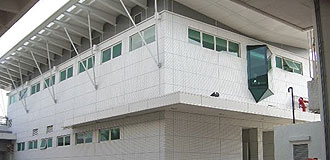New
Initiatives / Projects
Expansion Project at Sha Tau Kok Control
Point
The Expansion Project provided additional space and facilities
for customs clearance at the Sha Tau Kok Control Point. The
construction works started in December 2004 and were completed
in June 2006. Including the new detector dog kennel, Customs
office accommodation and examination areas have increased from
204 square metres to 777 square metres.
 |
| The new Customs
office building at Sha Tau Kok Control Point |
|
|
SkyPlaza
To meet the rapidly growing service demand and to sustain the
Hong Kong International Airport’s position as a major international
airport hub, the Airport Authority Hong Kong is constructing a
second Passenger Terminal Building, the SkyPlaza, which is scheduled
for commissioning in early 2007. As an integral part of the
passenger processing facilities, the Government will provide Customs,
Immigration, Quarantine facilities for air departure operation. Officers
of the department will be deployed to man the Duty Office for handling
dutiable commodities, endorsement of ATA carnet and general enquiries
for departing passengers. Customs officers will also man
the Staff Exit Channel and perform related checks at the Channel.
Expansion Project in Air Cargo Industry – Asia
Airfreight Terminal (AAT)
In view of the rapid development of the air cargo industry, the
Asia Airfreight Terminal (AAT) invested $1.75 billion to expand
its terminal (T2), the construction works of which have been completed. T2is
a multi-storey warehouse covering a gross area of 117 000 square
metres and. equipped with a state-of-the-art Material Handling
System (MHS) supported by the latest computer applications and
infrastructure, to perform a handling capacity of 910 000 tonnes
per annum. Upon commencement of its formal operation in two
phases by 2007, the two terminals will provide an aggregated cargo
handling capacity of 1.5 million per annum.
Expansion Project in Air Cargo Industry – DHL
Central Asia SuperHub (CAS)
To sustain Hong Kong’s position as the regional premier
air cargo hub, the Airport Authority Hong Kong granted a franchise
agreement to DHL to develop a new express cargo terminal at the
Hong Kong International Airport, namely the Central Asia Hub (CAH). Since
the commencement of CAH in June 2004, DHL has experienced a rapid
growth in the cargo volume.
In light of the upsurge in cargo volume, DHL announced to speed
up its expansion project named as DHL Central Asia SuperHub (CAS). The
new facilities will increase DHL’s parcel sorting capacity
from 20 000 to 35 000 pieces per hour and its document handling
capacity from 15 000 to 40 000 pieces per hour. To support
DHL’s expansion, the department will set up clearance facilities
with a view to providing effective and efficient clearance service
in CAS.
|

